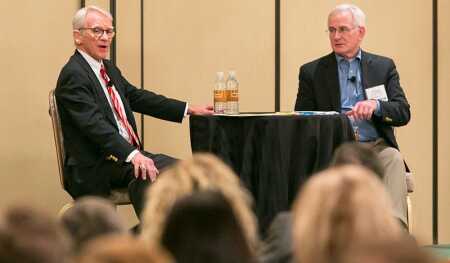As he completes his tenth and final term as Charleston, South Carolina’s mayor—and his 40th year in that office—Joseph P. Riley Jr. could speak only of all that he has left to do and how little time he has to do it.
There is the grand opening of the Gaillard Center, a $142 million performing arts center that will be the crown jewel of Charleston’s already world-class cultural scene; the private partners he seeks to support the so-called Lowcountry Lowline, a proposed greenway on a 1.5-mile (2.4 km) stretch of an abandoned Norfolk Southern railway; and the funds that still need to be raised for the International African American Museum, a $75 million endeavor that honors the legacy of Africans brought to the United States who began lives in slavery at Charleston’s harbor.
Related: Building Out Charleston’s Upper Peninsula
“I’ve got until the 11th of January next year, and I’ve got so much to do,” Riley, 72, told a crowd at the ULI Carolinas’ Second Annual Meeting, held February 9–10 in Charleston. Three district councils – ULI Charlotte, ULI Triangle, and ULI South Carolina – received an Urban Innovation Grant from the ULI Foundation to support the conference.
Riley is a ULI J.C. Nichols Prize Laureate, having received the prize in 2000, its inaugural year, for his visionary leadership as Charleston’s mayor and as, perhaps, the most beloved politician in America.
In a wide-ranging interview with former Pittsburgh mayor Tom Murphy, ULI senior resident fellow and the Canizaro/Klingbeil Chair for Urban Development, Riley recalled the uncertain future Charleston faced when he took office in 1975. People had fled the urban core for the suburbs, and the city’s historic architecture hadn’t been preserved or redeveloped as it would be under Riley’s leadership.
“People were afraid of cities and wondered really if they had a future ahead of them,” said Riley. “What I felt was that Charleston could be a great American city. Greatness has nothing to do with size. It has to do with quality.”
Having no formal training as an architect or a planner, Riley nonetheless became an expert in sound urban design. He praised Charleston’s commitment to its strategic plan for the city’s redevelopment. The plan called for the complete overhaul of King Street, downtown’s main commercial corridor, which is now bustling with high-end boutiques, destination restaurants, and swank hotels. These included Charleston Place, now owned by resort company Belmond, whose redevelopment in 1986 kick-started downtown’s renaissance. One Sunday a month, King Street becomes a pedestrian mall jammed with the foot traffic of tourists and residents alike.
“We invested in quality every chance we had,” Riley said. “You can’t just accept ‘stuff’. . . . A building has to be real and it has to honor the street.”
In fact, Riley felt so strongly about educating other mayors about urban design that he established the Mayors’ Institute on City Design, a joint initiative of the National Endowment for the Arts in partnership with the American Architectural Foundation and the U.S. Conference of Mayors.
Murphy said that many cities pursue development on a transactional basis without having an overall vision or strategic plan for where the development “fits into the larger picture of how this will make a great city.”
“Your investment becomes more valuable if it’s part of a vision,” Riley concurred.
Beautifying Charleston has been an integral part of Riley’s vision for a prosperous, economically viable city that ultimately creates opportunity for its citizens. “Every investment in beauty yields an economic payoff,” he told ULI in an interview after winning the Nichols Prize. “If you build beautiful places . . . the land next to these places becomes more successful.”
He sees projects that enhance the physical beauty of the public realm as economic drivers: the Spoleto Festival USA, a 17-day performing arts festival that occurs each year in late spring and draws 80,000 visitors to the city; Waterfront Park, a 13-acre (5.2 ha) park next to the Copper River that has attracted $337 million in private investment; and affordable housing complexes that are aesthetically appealing and have the look and feel of real homes.
According to Riley, the secret ingredient in making a Charleston a world-class city was “never once losing an ounce of passion for excellence.”





